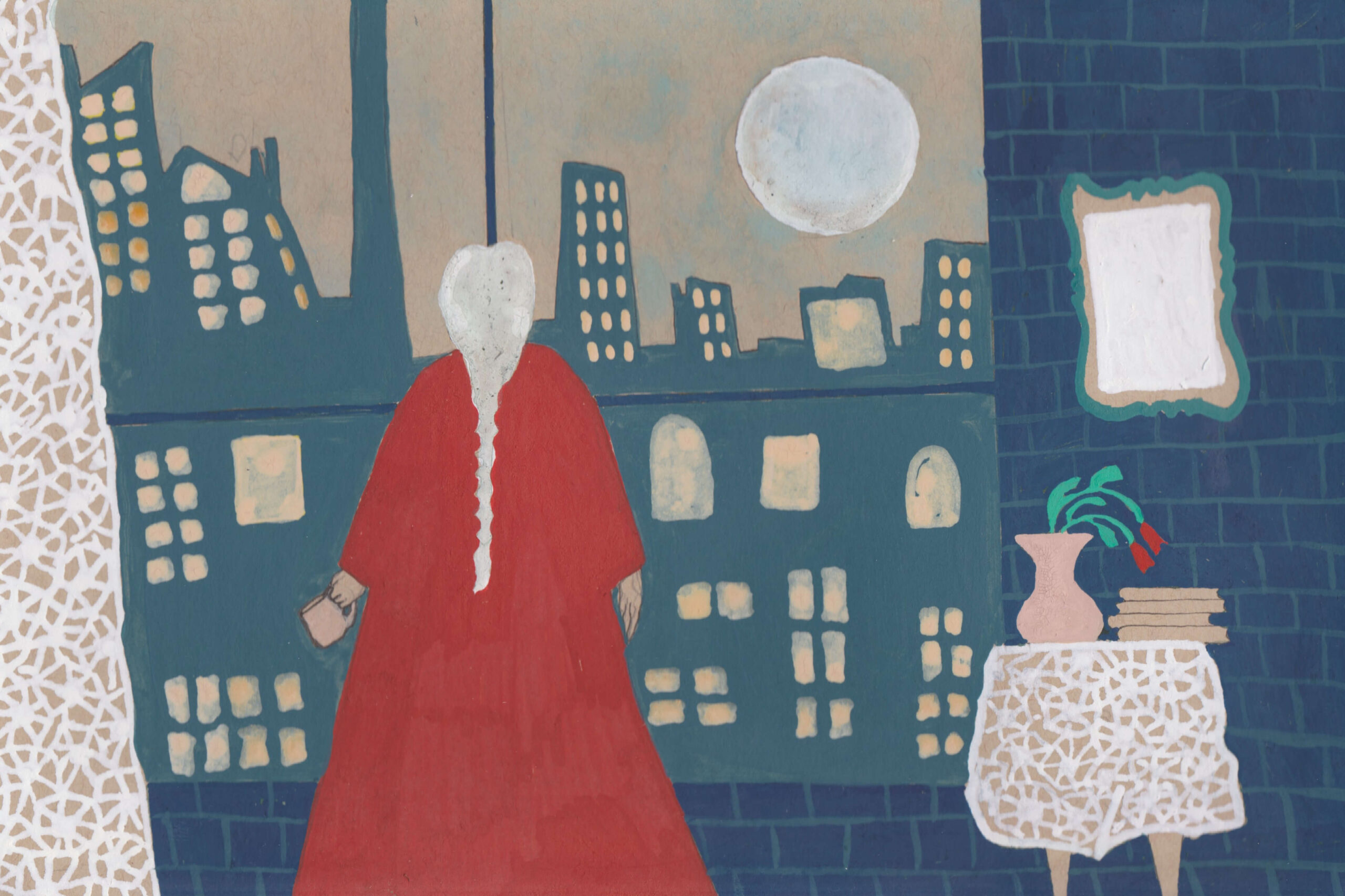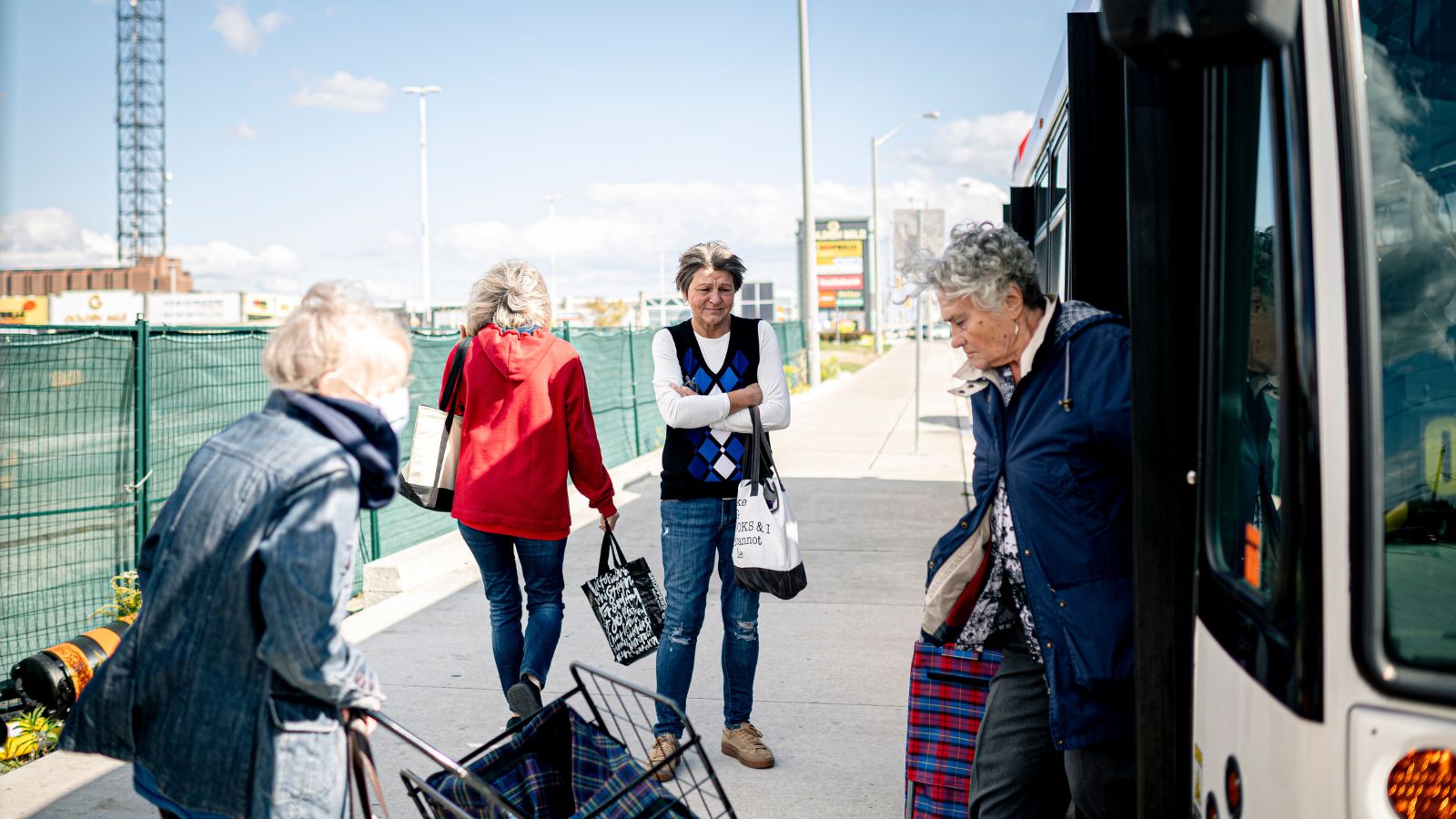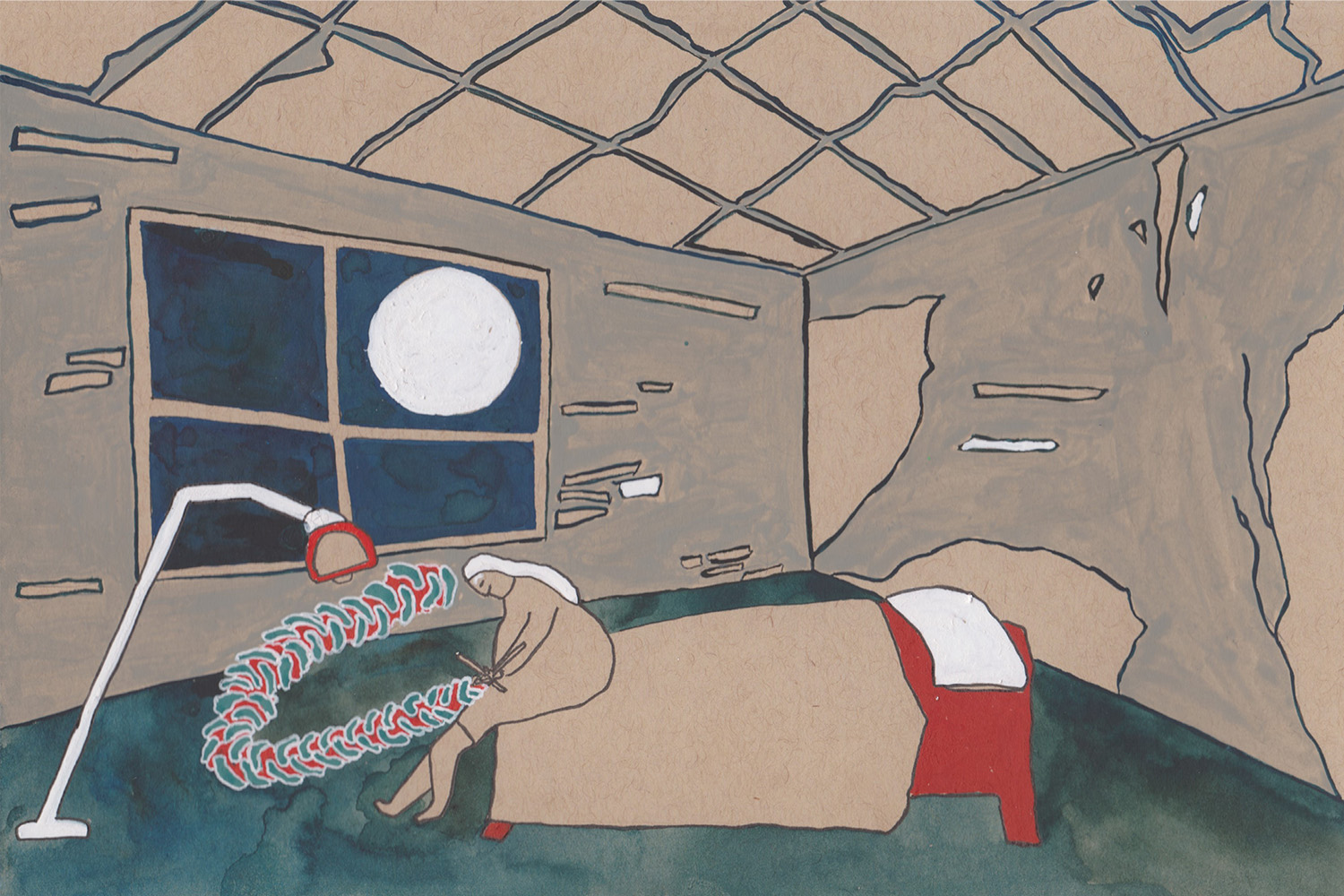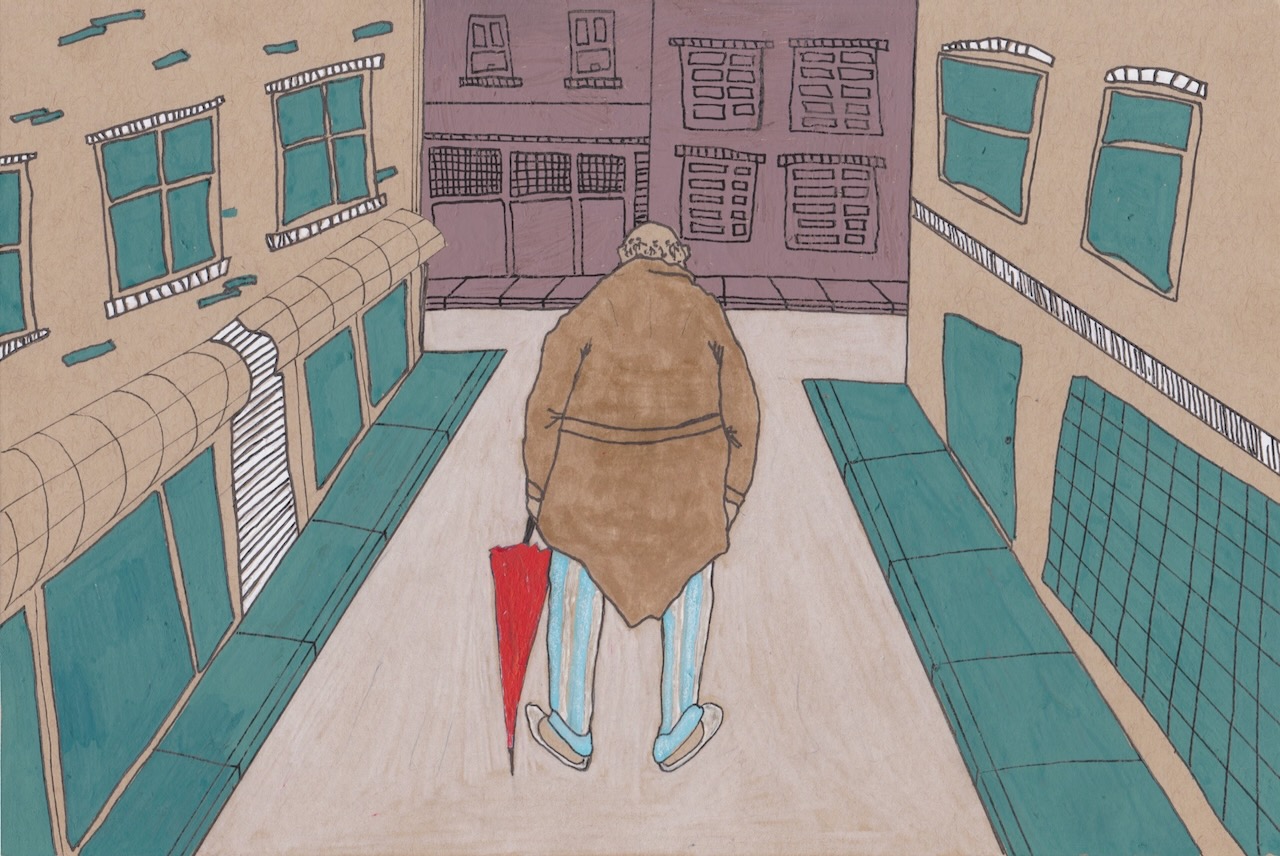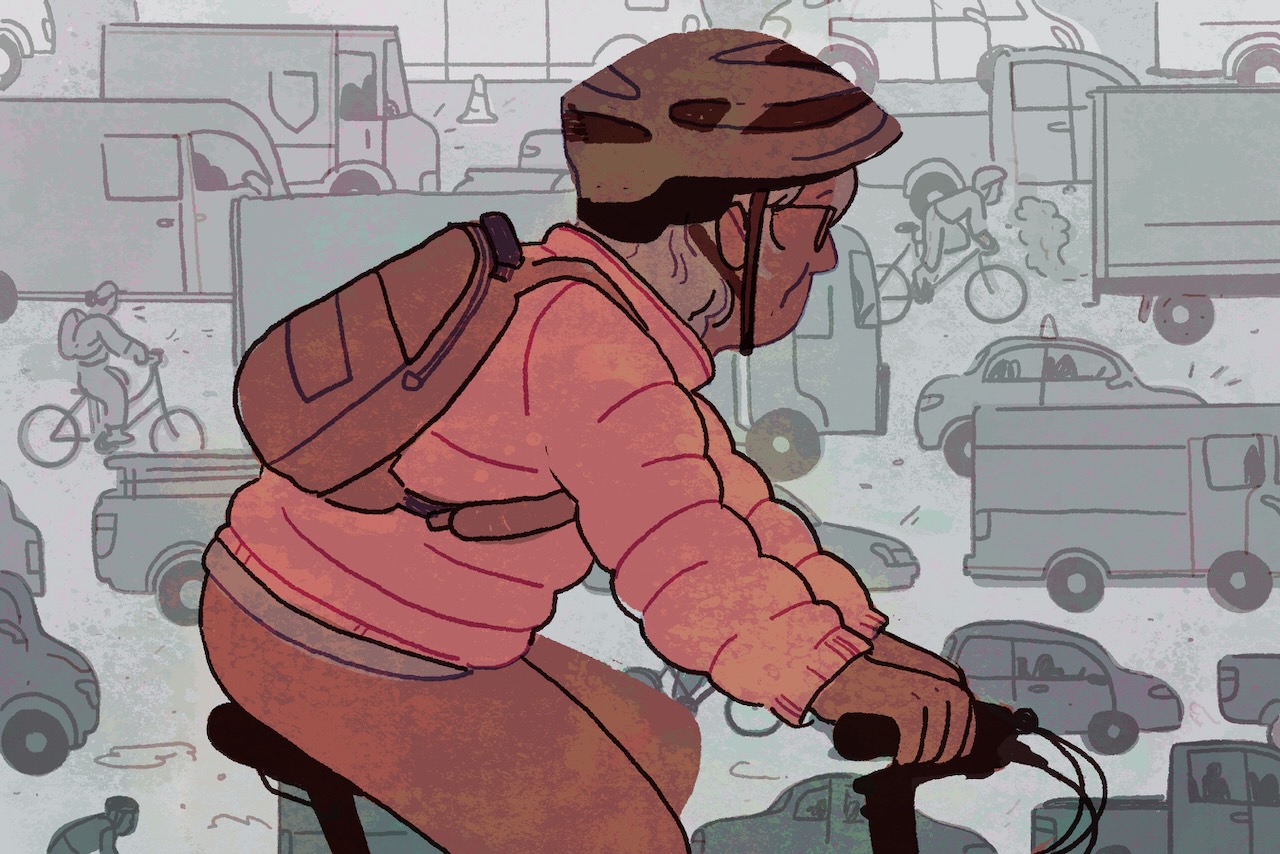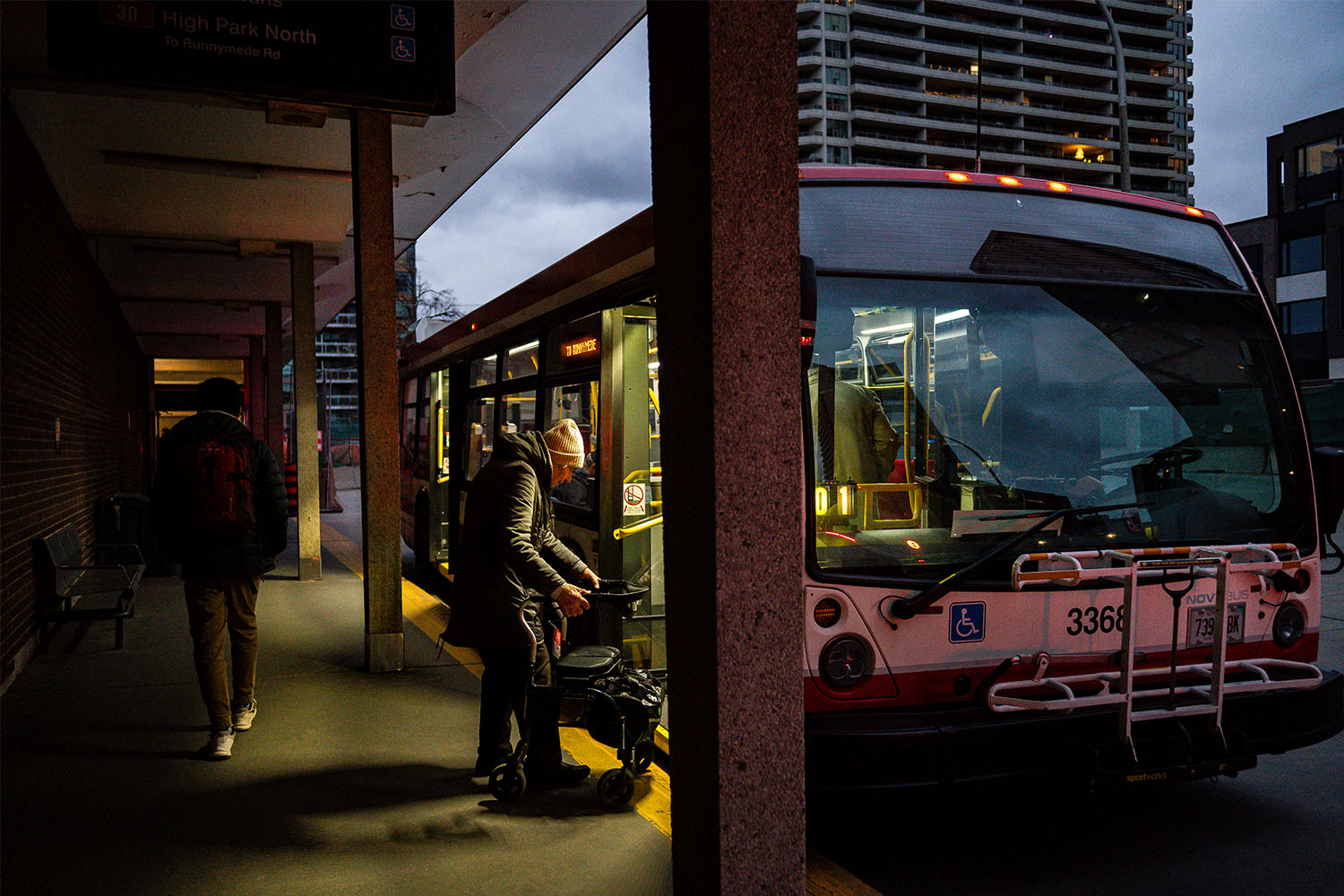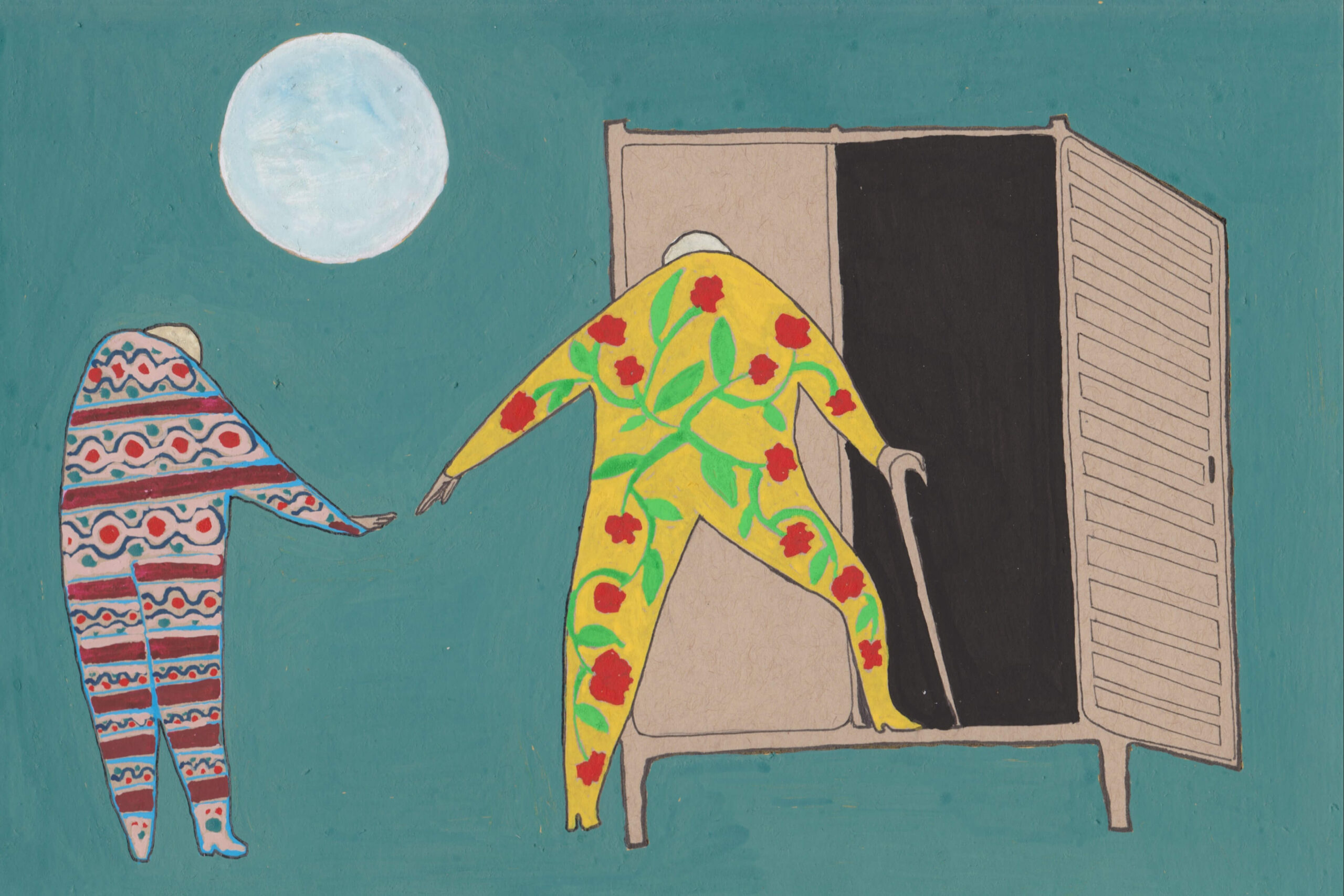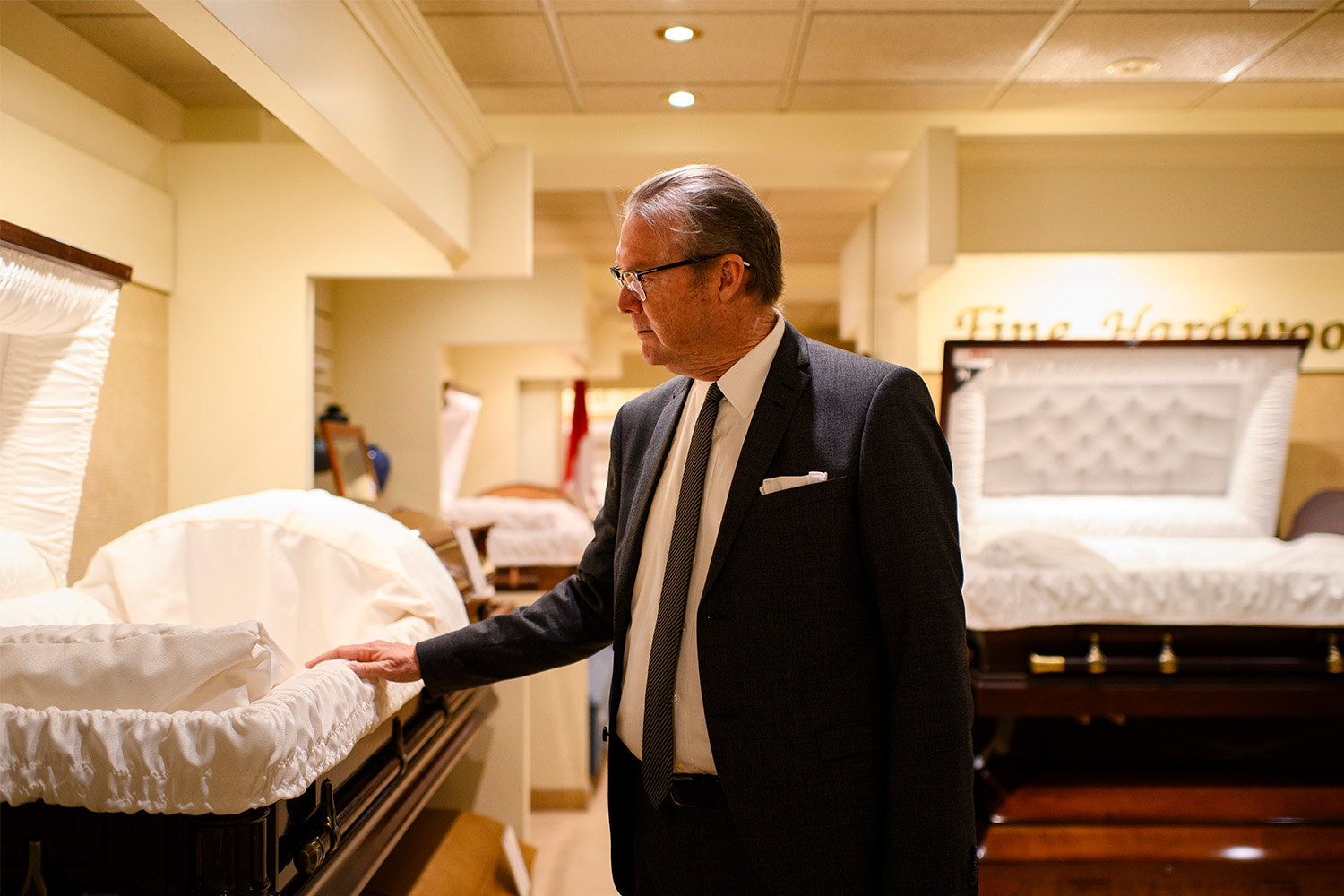
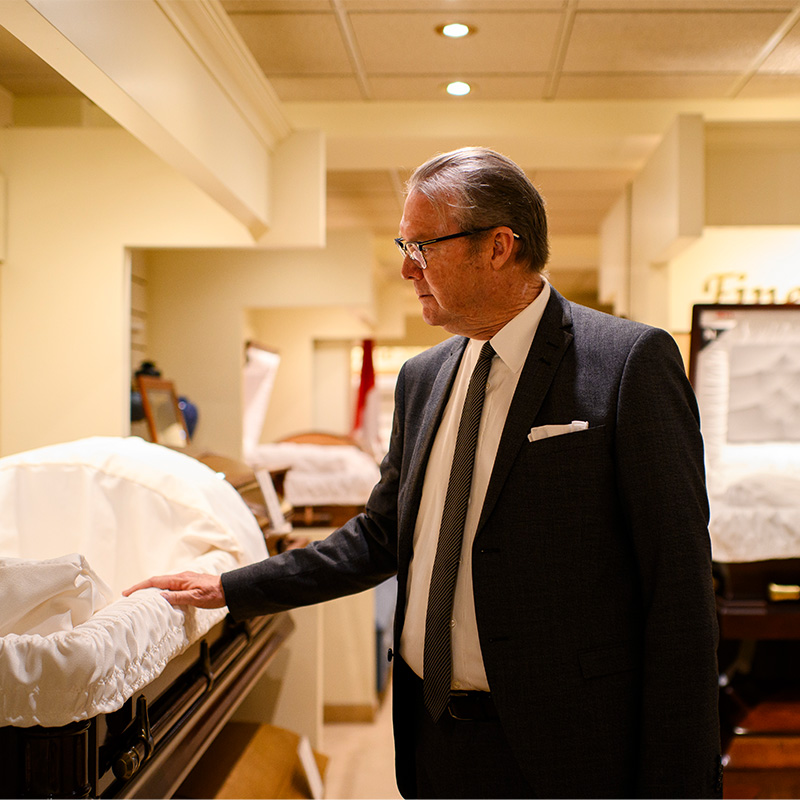
In a corner of the basement of the Humphrey Funeral Home—a red-brick building with white columns in a wealthy North Toronto neighbourhood—is a nondescript door with a large plaque that reads, simply, “RESPECT.” It’s the entrance to the preparation room, where the deceased are readied for viewing. The sign is a reminder to staff that, while this might be just another day at the office, the business of death is primarily about dignity.
Kim Hunter, the home’s president and owner, has walked past that sign nearly every working day for more than 30 years. Now 67, Hunter has grey hair and the unassuming self-possession of someone who could both effectively run a funeral service and, as required, melt into the background.
The Humphrey Funeral Home has been around since 1879, and for the last 70 years, has sat on Bayview Avenue, just up the street from Mount Pleasant Cemetery—a sprawling, historic 200-acre burial ground. When Hunter began at the home in the 1980s, and for the first decade of his tenure, he remembers a feeling of cooperation, even friendship with his colleagues at the cemetery.
Back then, Hunter says, cemeteries and funeral homes were “completely different animals.” Funeral homes were responsible for collecting and preparing the deceased, hosting services, ordering flowers, everything up to the moment the casket reaches its final resting place—the rest was the responsibility of the cemetery, which handled everything from burial onward. During working hours, Humphrey’s and Mount Pleasant Cemetery were often the two limbs of a single organism, working together to lay a body to rest. Clocking off, workers would mingle. “We played hockey together, we played baseball together, we curled together, we would get together and do pub nights,” Hunter remembers. They had, he says, “a very close, intimate professional relationship.”
Sign up to our free newsletter to get award-winning local journalism delivered to your inbox.
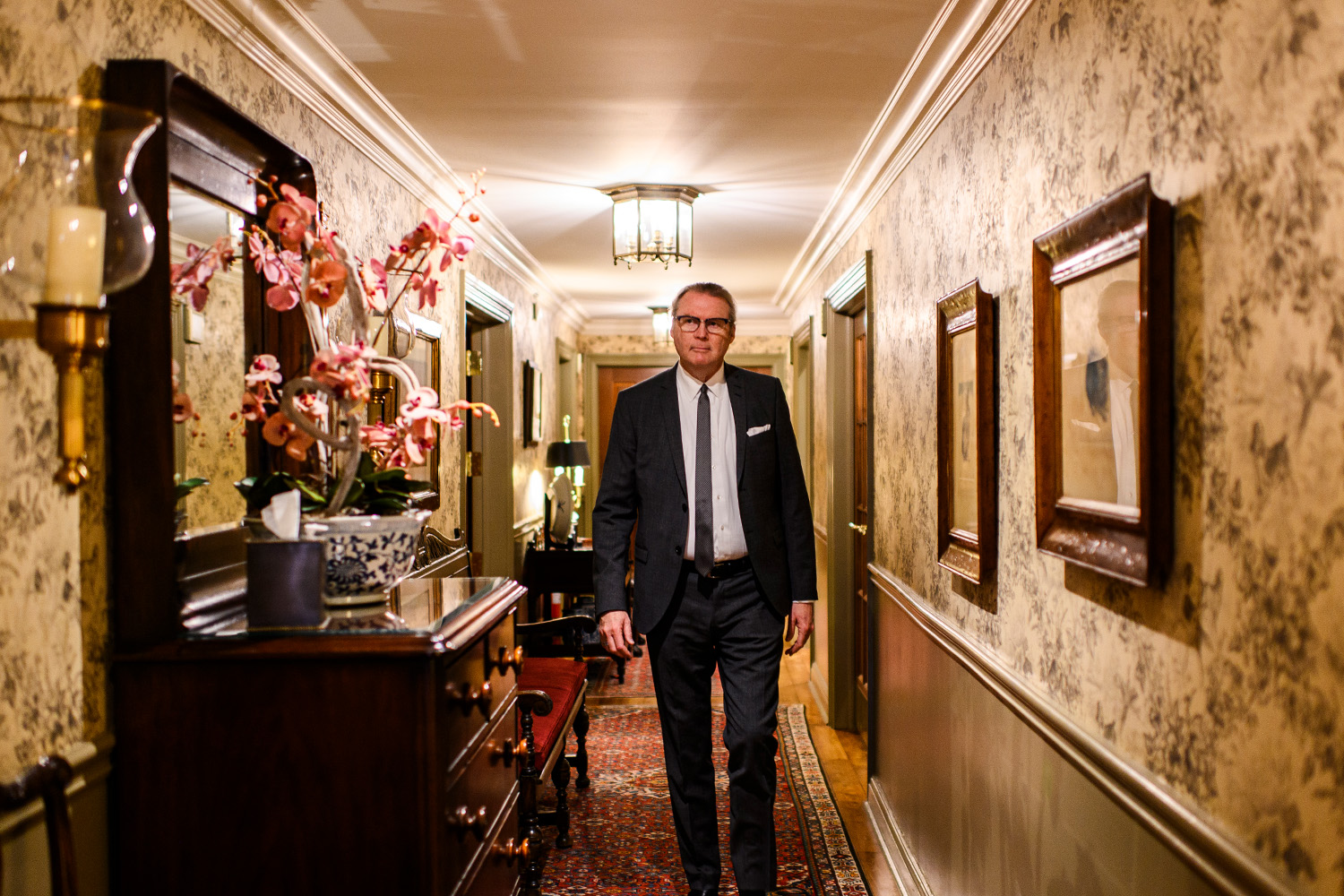
Over the last few decades, however, that relationship has changed. Hunter is the first non-Humphrey to own the funeral home in its 145-year history, and has strived to keep it out of corporate hands. Meanwhile, the Mount Pleasant Group of Cemeteries, the company behind Mount Pleasant Cemetery and nine other burial grounds in the GTA, has expanded into an industry behemoth. It has become, to the dismay of any funeral homes in its proximity, a one-stop-shop for all your funerary, burial, and cremation needs. And it has changed from a colleague into a competitor.
“It was almost like a change in corporate philosophy,” says Hunter. The pub nights stopped. Hockey season ended forever. “We were the enemy, as opposed to a co-professional.… That relationship changed, and went very stark and very cold.”
From his position up the street, Hunter has witnessed the transformation of Mount Pleasant, and of the bereavement sector in general. For the last decade, he’s seen the strange, under-the-radar battle between the Mount Pleasant Group and its critics. It’s a fight that has unfolded in courthouses and industry backrooms, on ethical and financial grounds, about what exactly the Mount Pleasant Group of Cemeteries is, and what it should be.
Where other bereavement companies usually fall into the categories of charities or for-profits, religious institutions or municipal ones, the Mount Pleasant Group stands alone in the city—it’s a private, commercial entity, operated through a financial trust, and founded on public money and a government statute. It’s not-for-profit and has no shareholders, but has some of the most expensive burial plots in the country. It only operates in the GTA, but has provincial lobbying power comparable to that of its corporate multinational competitors, which it has used to reshape the industry to its own advantage.
If the Humphrey Funeral Home offers Torontonians a romantic vision of death care—a small company putting “respect” above all else—the expansion of the Mount Pleasant Group reveals the uncomfortable reality of the bereavement sector: at its heart, it is about money and real estate. The investments and purchases made by key players, some a hundred years ago and some today, will decide the future of whether, where, and at what price point all of us will be laid to rest. And in a city rapidly running out of burial space, those questions matter more now than ever.
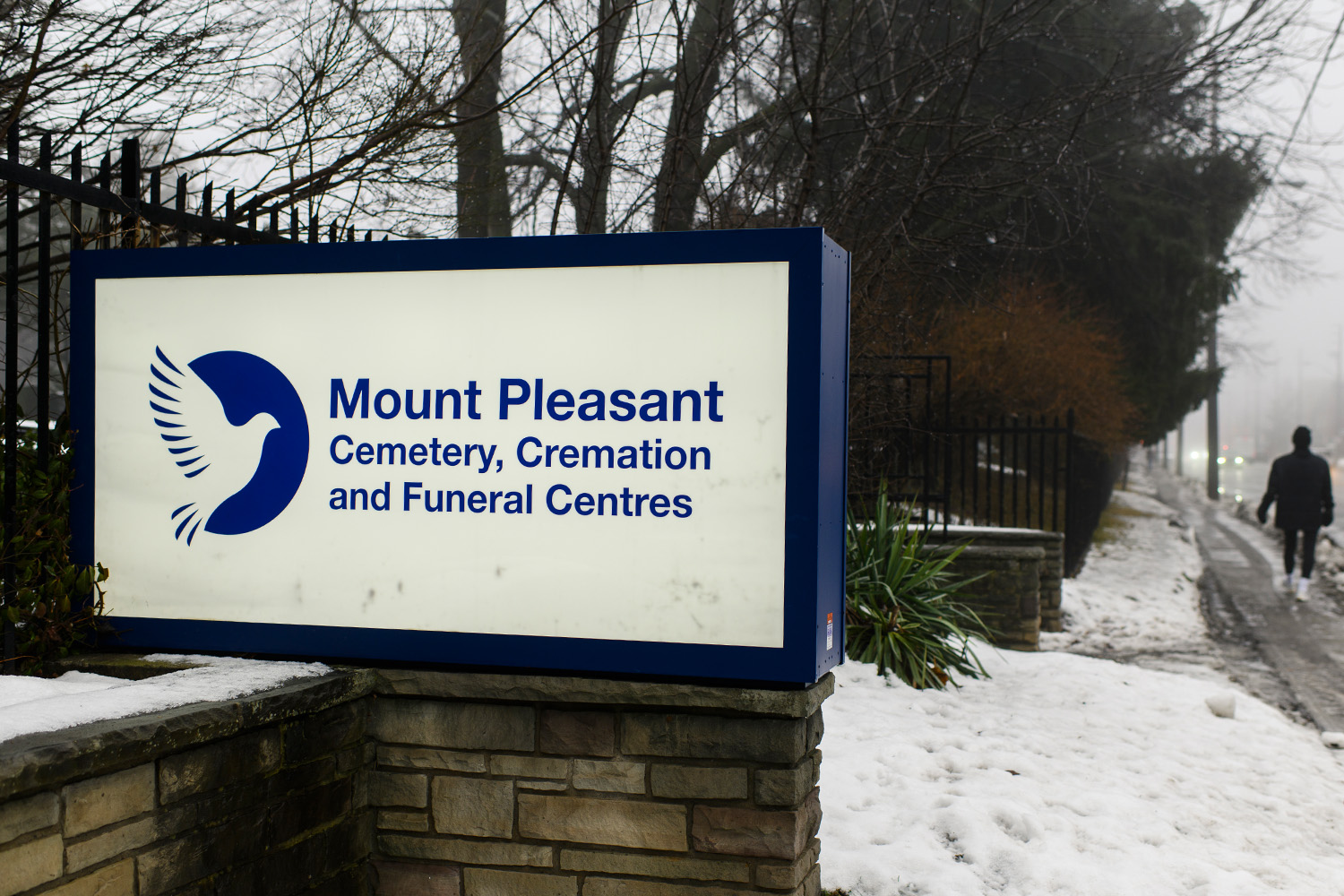
One day in early September 2016, Nicole Hanson sat down outside Toronto City Hall and began to cry. She had just delivered a deputation to the city’s Planning and Growth Management Committee. It had not gone well.
Hanson, a young, bright-eyed Black woman, is an urban planner with a unique expertise in the development of cemetery spaces in population centres. And like a modern-day city planning Cassandra, she’s spent years warning of a looming crisis: the city is running out of land to bury its dead.
That day in 2016, she appeared before the Planning Committee with three powerful industry experts to back her—executives from the Catholic church, for-profit bereavement giant Arbor Memorial, and the Mount Pleasant Group. They were sharing some pretty dire numbers. Citing Statistics Canada, they reported that by 2038, 25,000 Torontonians will die every year, an increase of 7,000 over current rates. Of the 206 registered cemeteries in Toronto, only 23 are active. All of them will start running out of burial space in 10 to 30 years, even accounting for the falling burial rate and rise in cremations. In a matter of decades, anyone hoping to bury a loved one will have to drive three to four hours north of the city to find a spot.
“Toronto prides itself on being a world-class city, a city that plans for birth, life, work and play,” Hanson told the Planning Committee. “But we do not plan for death at all.”
The Committee did not seem to grasp the urgency of the problem. City staff had no capacity to look into it, they told her, and one councillor went so far as to say this was solely a private-sector issue. It isn’t: York Region and Mississauga had both done cemetery needs analyses within the previous year, ahead of future planning, prompting Hanson’s visit. When her five minutes were up, with no questions from council, she returned to her seat and leaned over to the person next to her. “I don’t think they were listening,” she said, laughing uncomfortably, trying to stifle the spiralling sense that no one cared about this particular crisis. She wondered why she’d gotten into this line of work.
“The living city mirrors the city of the dead. How you live is how you die,” Hanson told me one day this January. “Cemeteries reflect the housing crisis that we’ve been dealing with in Toronto, with land being at such a premium.”
This means the equity issues plaguing our city—questions of affordability, of access to space, of newcomers and minorities being pushed out farther and farther—cannot be escaped even in death.
The governments of aging populations in dense urban centres across the world are already having to face this problem. Hong Kong has been actively encouraging its residents to be cremated; Singapore has a 15-year limit on burial plots, after which the remains are disinterred and cremated. In Toronto, Hanson says, there are options. We could backfill cemeteries—interring people in the spaces between existing graves. We could introduce community burial grounds, smaller cemeteries built into local parks and parkettes. And, as much as the idea might be discomfiting to some, we could bury people in the Greenbelt—which would, in theory, only add to the need to protect and preserve it.
All of those solutions could be contentious. But thus far, the city isn’t even recognizing the problem.
In 2016, the Mount Pleasant representative sitting before council warned that Toronto would be the first municipality in the province, or possibly the country, to run out of burial ground, but the problem would soon spread across the GTA. He urged the municipal government not to set the issue aside again as they had before, pushing it off to a future that was rapidly closing in.
The Planning Committee deferred the motion indefinitely. Seven years later, it still has not been revisited.
“Toronto prides itself on being a world-class city, a city that plans for birth, life, work and play. But we do not plan for death at all.”
Nearly 200 years ago, at a similar moment in which burial space was urgently needed, the idea of Mount Pleasant Cemetery was born.
At the time, the modern cemetery was just a couple of decades old. Until then, people were most often buried in their local churchyards, in the countryside, or on family plots on private land. Overcrowding, neglect, theft, and vandalism had left urban churchyards at the start of the 19th century in dire condition. “In England, local newspapers published lurid stories of churchyards swimming in black slime with disinterred corpses strewn about,” heritage planner Sally Coutts wrote in a 1986 article on the history of Mount Pleasant Cemetery.
The crisis in churchyards coincided with changing social norms that pushed back against the taboos around death. The result was the concept of the garden cemetery—acres of grass and tree-lined paths winding through rows of headstones and monuments where visitors could commemorate the dead and take in the pleasures of the natural world.
In Toronto, then called the town of York, there was a desperate need for a decent, local burial ground for the rising number of non-Anglican and non-Catholic residents. In 1825, against this backdrop, advocates petitioned the legislature to establish a nonsectarian cemetery on the outskirts of the city. The land was bought with $300 gathered from city residents in the interest of the public good. The nonsectarian cemetery was established first on a six-acre plot at Yonge and Bloor known as Potter’s Field, then at the Necropolis in Cabbagetown, before developers landed on the site between Yonge and Bayview, an impassable, thistle-dense ravine that would come to be Mount Pleasant. The grand cemetery opened on Nov. 4, 1876.
The group appointed to build and manage it, the Toronto General Burying Grounds Trust, knew that many burial grounds were left abandoned and penniless after spaces filled up and the flow of revenue stopped. (Years later, a district officer for health in the eastern counties of Ontario would report that one in every three cemeteries he encountered had fallen to such ruin.) So in the 1880s, in a move that would prove to be key to its continued survival, wealth, and power, the group established a perpetual care fund. About 70 years before it became a legal requirement in the province, the trust began setting aside funds to care for the cemetery far into the future.
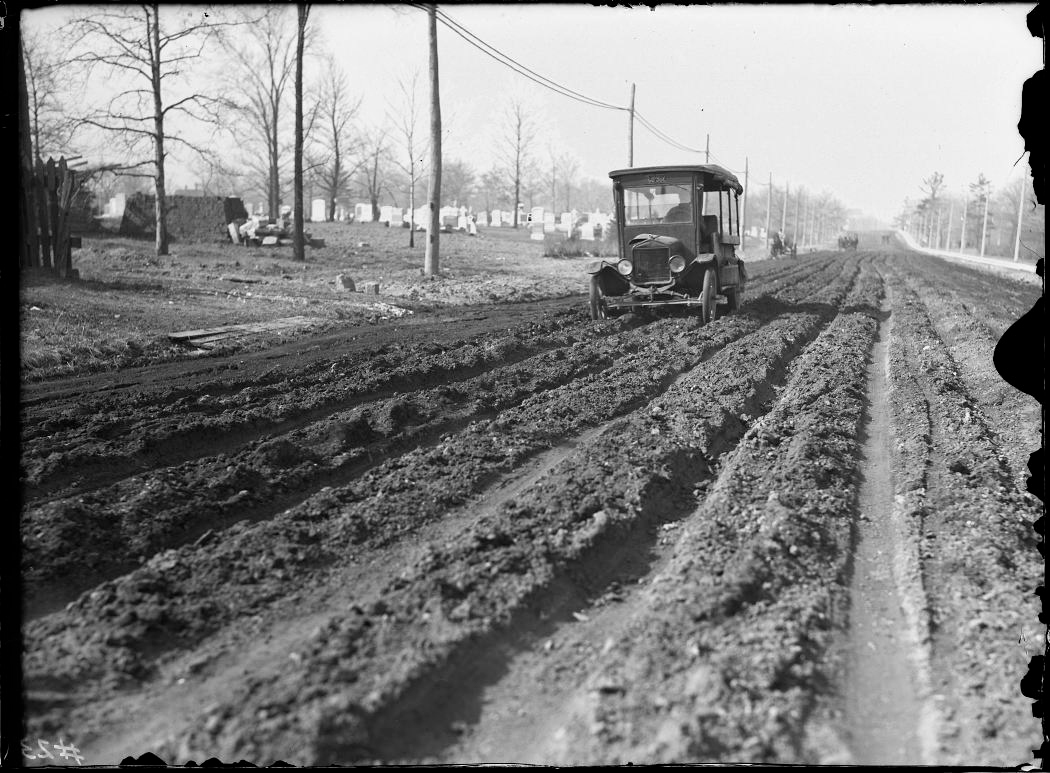
For nearly the first century of its existence, Mount Pleasant’s partners and competitors in the Toronto death business were mostly mom-and-pop operations—private, family businesses, or at most, local chains with a handful of locations. Funeral homes and cemeteries were operated separately, and the latter were largely non-profit. That changed in the 1980s.
“Death doesn’t stop during a recession, but it impacts the funeral industry,” explains Virginia Beard, professor and department chair at Longwood University in the U.S., and researcher on the North American bereavement industry. At independent funeral homes across the U.S. and Canada, “costs were climbing, and the profits were falling. As it became more difficult for families to operate the small funeral homes, corporations started going around [buying] them up.”
That continent-wide death-care gold rush didn’t end with funeral homes. “They then started going to different sectors of the death business,” Beard says. “So now they’re not only running funeral homes, they’re also running cemeteries.”
In some ways, the corporatized funeral industry began to resemble today’s long-term care industry: massive corporations bought up family-owned businesses but kept the name, leaving locals none the wiser to the shift in ownership. Prices often suddenly rose—the Loewen Funeral Group, once the second-largest company in the bereavement industry, raised prices by 15 percent in every independent funeral home it purchased to make up for the acquisition costs. In places where companies operated a number of local funeral homes and cemeteries, the days of a single funeral director seeing to every stage of the process were over, Beard says. There was almost a “McDonald’s-ization” of the industry, an assembly-line process to handling bodies.
The consolidation of the bereavement industry had natural limits. Today, independent operators still run most of the bereavement sector in North America, especially outside urban centres, where large corporations quickly realized that there isn’t much benefit to buying up small funeral outfits. But in Ontario, a quarter of the bereavement industry, as of 2018, is run by just four industry giants: the Mount Pleasant Group, Arbor Memorial, Park Lawn, and U.S-based Service Corporation International (SCI).
There is nothing inherently wrong with a corporation running a funeral home or a cemetery. But death care is like health care: everyone needs it eventually, and when you do, you’re likely in a very vulnerable frame of mind.
In 2017, a joint investigation between the CBC Marketplace and the Toronto Star found that staff at Arbor Memorial used “high-pressure sales practices, significant price markups and aggressive upselling” in their interactions with undercover journalists posing as grieving family members, and marked up casket and urn prices by an average of 185 percent compared to wholesale rates. A 2020 Auditor General of Ontario report on the need for better regulation in the bereavement industry revealed its mystery shoppers experienced sales pressure or received misleading information at half of all the operations they visited. During the pandemic, as small funeral homes and cemeteries buckled under the pressure of an unforeseeable mass-casualty crisis, stock prices at SCI, and to a lesser extent, Park Lawn, shot to all-time highs. Stock market guides encouraged investment in the bereavement industry, rather gleefully describing the profits predicted in the coming decades as baby boomers begin to die in greater numbers.
Mount Pleasant is, notably, not a for-profit entity. It has no shareholder pockets to fill. But it has grown alongside its national competitors. Between 1965 and 1993, it doubled its cemetery acreage and expanded outward from Toronto to Brampton, Richmond Hill, Oshawa, and more. And because it operates predominantly in the GTA, the province’s most populous region, it has been able to keep up with its competitors despite having far fewer locations. In 2018, Mount Pleasant performed about as many burials and scatterings as Arbor Memorial despite having only half as many cemeteries in Ontario, and actually performed more funerals than Park Lawn despite having less than half as many funeral homes.
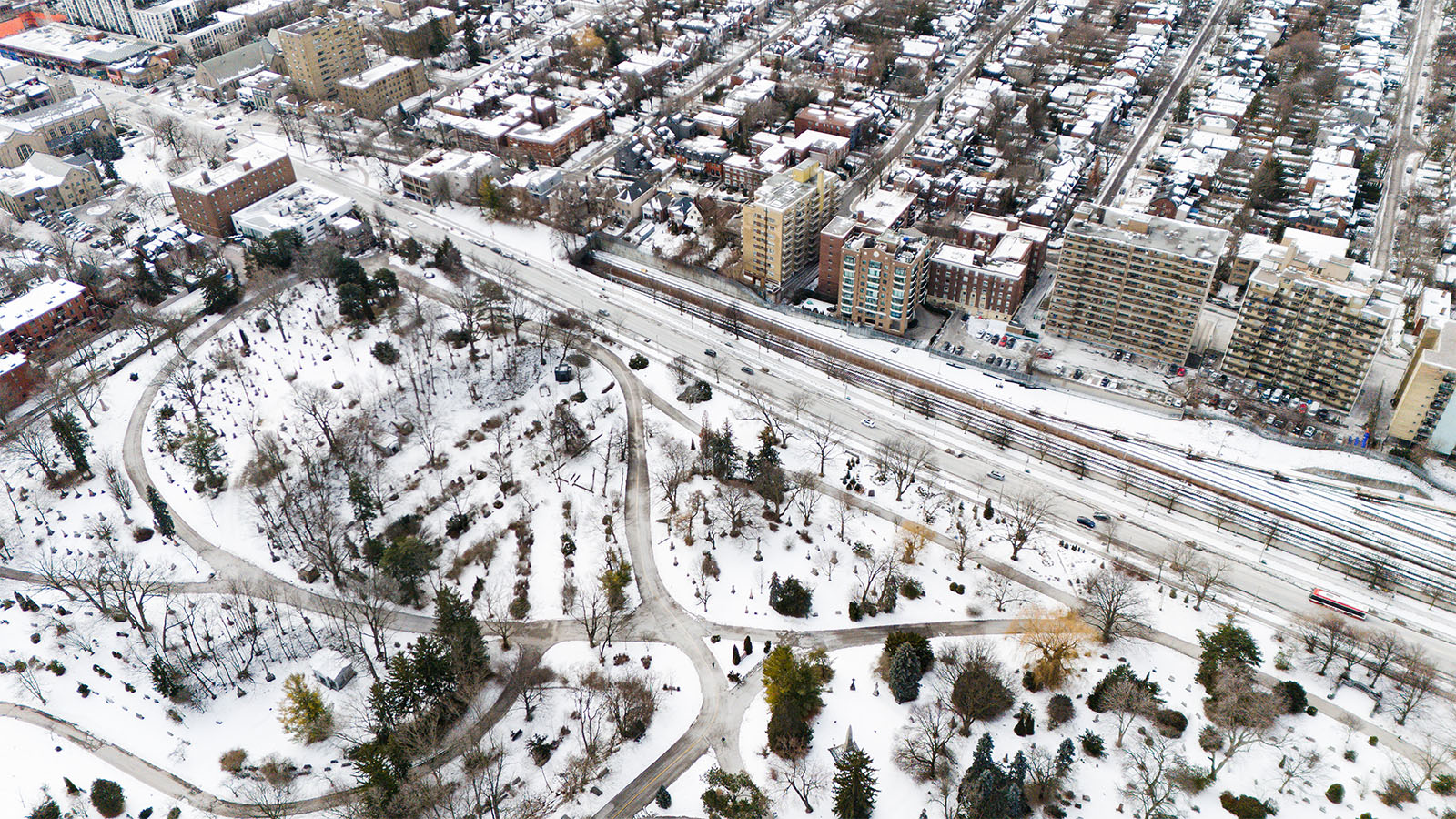
And the trust begun in the 1880s to ensure the perpetual care of the cemetery has ballooned in the century and a half since. In 2011, then-Mount Pleasant Group president Glenn McClary wrote in the company’s annual report that the company’s perpetual care fund was “$300,000 per developed acre, which is the highest of any cemetery company in North America.” That’s about $350 million. In 2014, a Globe and Mail article on the bereavement industry noted that Arbor Memorial, with four times as many cemeteries as Mount Pleasant Group, only had $240 million in its trust.
Today, the fund sits at $581 million. The cemetery has $1.2 billion in total assets, and hundreds of millions in annual revenue from cemetery and funeral services in the GTA. Quietly, the non-profit cemetery formed as a trust has become extremely rich, prompting some to ask: what was their local cemetery doing with so much money and power?
The Mount Pleasant Group declined to speak with The Local for this story. In a statement, it wrote: “In the event revenues earned are in excess of expenses, that money is re-invested into the care and maintenance of our cemeteries, is put aside to fund long-term enhancements to our operations and facilities in keeping with the ever-changing needs of GTA families, or is used to secure new lands for cemetery development.”
“As with any service-providing organization, our services have expanded over time and to meet the changing needs and demographics of the communities where we operate,” it added.
But quietly, while the Mount Pleasant Group expanded its cemetery holdings, something unexpected was happening: across North America, people began to choose cremation over burial. This shift in social norms meant the channels through which money flowed into the industry were changing—and if Mount Pleasant wanted to guarantee its own existence in perpetuity, it would have to adapt.
The equity issues plaguing our city—questions of affordability, of access to space, of newcomers and minorities being pushed out farther and farther—cannot be escaped even in death.
Brian Soares is selling two burial plots in Arbor Memorial’s Highland Memory Gardens, in North York. At $12,500, he is—by local standards—practically giving them away.
Soares, a 70-year-old Etobicoke resident, has found himself in a situation that is increasingly common among the aging children of elderly parents whose twilight years coincided with a shift in the norms around interment: he’s selling the burial plots they never used, and the sale promises an unexpected windfall. The plots his parents bought decades ago for maybe $500 have skyrocketed to $31,000.
The market for burial plots on Kijiji is slim, but Soares is in no rush. “I don’t want to gouge anyone,” he says. “So I figured, well, I’d start at halfway there, and see.”
On Kijiji, he’s got competition—a quick search reveals a couple dozen results for burial plots, ranging from $4,000 to $75,000. Many of the sellers have similar stories: parents or in-laws who, thinking they were planning for the near future, bought plots in their 60s, and are now reaching their 80s and 90s and facing changes of heart, circumstance, and location. Olivia Mah, an Oakville resident in her 40s, is selling off her mother-in-law’s double plot at Mount Pleasant Cemetery for its $60,000 market price. She’s treating it a little like a real estate opportunity: “It’s a fixed cost…and that value is only going to increase because of the scarcity of the product.”
The Kijiji sales are a small snapshot of a bigger trend: in the 21st century, people aren’t getting buried the way they used to. By the turn of the century, cremations, once an outlier in the cemetery business, were becoming more and more popular. As the cost of living has risen, the cost of a burial plot—averaging $5,000 to $10,000 nationwide—is, for many, hard to justify. Immigration rates helped boost this trend, too. In Hinduism, for example, it’s traditionally the responsibility of the first-born son to light the funeral pyre of a parent. Today, that son presses the ignition button on the cremation machine.
In Ontario, these industry shifts triggered a panicked flurry of activity in the cemetery sector, motivated by an industry-wide realization: in the new millennium, the question of how one is memorialized (the business of funeral homes) matters more than where one is laid to rest (the business of cemeteries).
The problem for Mount Pleasant was that in Ontario, companies were historically not allowed to own both cemeteries and funeral homes, a measure to prevent anti-competitive behaviour. That changed in the late 90’s when Mike Harris’s red tape reduction policies aligned with intensive lobbying by Mount Pleasant and other industry giants, both seeking to consolidate the death industry and cut government-imposed restrictions. Joseph Richer, registrar for the Board of Funeral Services at the time, recalls years of acrimonious debate and jockeying between representatives of major players and smaller businesses like Humphrey Funeral Home. In one meeting, he was asked what he thought the middle ground was. “There’s no middle ground,” he recalls saying. “There’s a winner and a loser. The cemeteries, they can cordon off land and add a funeral home. A funeral home can’t add a cemetery.” (Full disclosure: Richer is my partner’s uncle.)
That legislation, which took a decade to write, cleared the way for Mount Pleasant to build funeral homes and crematoriums and profit from the shift in burial practices. By 2010, cremation made up more than half of all last rites performed in the province, and it has gone up by another 10 percent in the decade since. And it’s no coincidence that the rising popularity of cremations, which reduced industry profits, coincided with the bereavement industry offering more and more customized, hyper-individualized options to their clients, each with an add-on fee that padded out the final bill.
Today, there are more ways to be seen off to the next world, to be celebrated for your life, than the first undertakers could’ve thought up in their wildest dreams. You can be turned into jewelry, a tree, a firework, a watch or an hourglass (so you can, as the joke goes, forever tell your spouse they’re running late), a diamond, a frisbee, a vinyl record, a teddy bear, a coral reef. You can, at the suspiciously affordable cost of $5,000 USD, be rocketed into Earth’s orbit. You can even be frozen in liquid nitrogen and then shaken vigorously until your remains are in small, scatterable pieces. Most of these processes will cost you less than a cemetery plot in the city of Toronto, and all can, in theory and with the right technology, be offered by venerable cemeteries that were once solely in the business of offering gravestones in quiet parks.
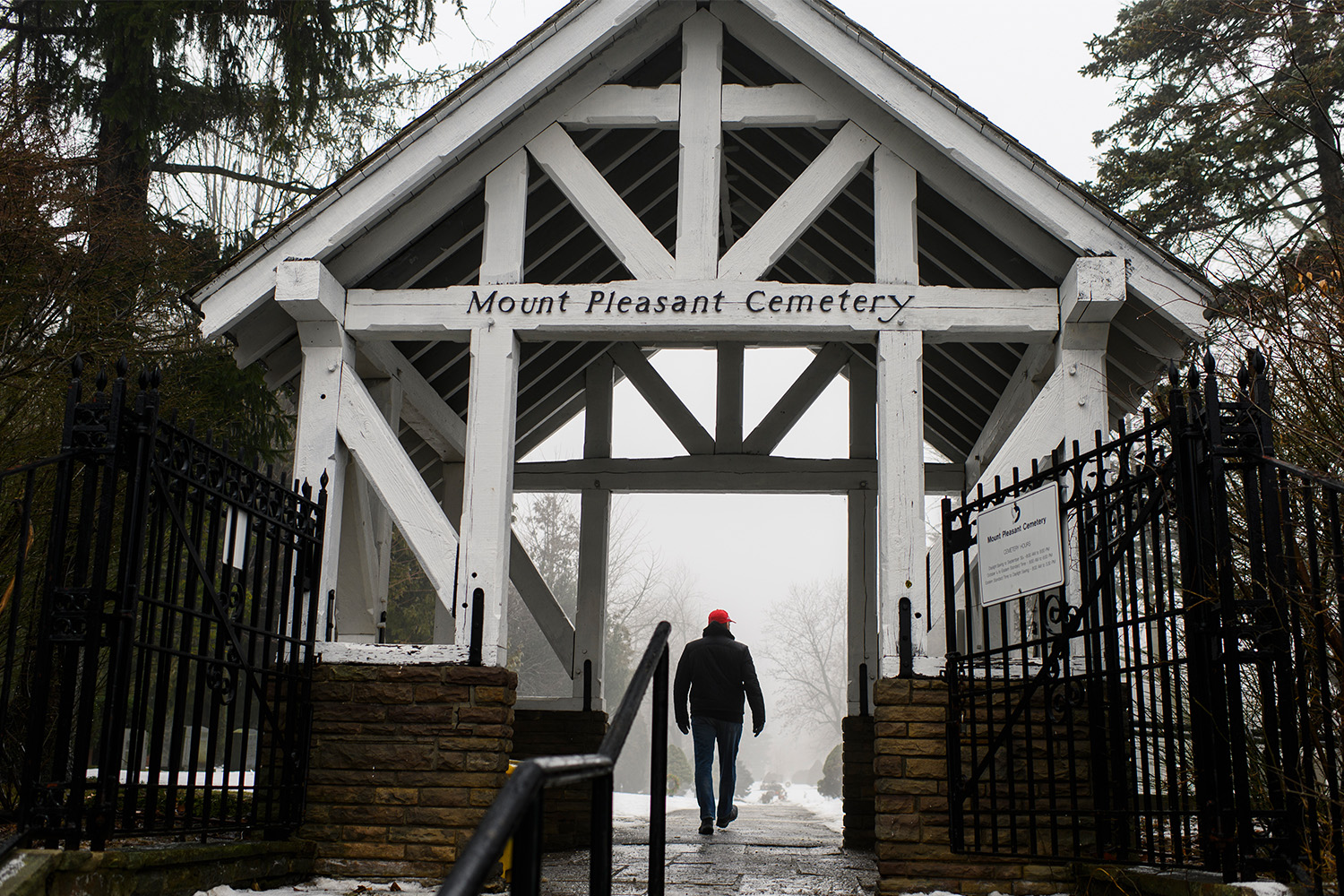
On a bitingly cold, sunless day in December, Margot Boyd and Pamela Taylor offer to take me on one of their Mount Pleasant Cemetery walks. Boyd—small and birdlike, with seemingly endless reserves of energy—is the president of the now-lapsed Moore Park community organization Friends of Toronto Public Cemeteries, a group advocating for transparent and public governance of the Mount Pleasant Group of Cemeteries. Taylor, a taller blonde with an expensive-looking bob who was wearing dark glasses to recover from a recent eye procedure on the day I met her, is a lawyer by trade. She met Boyd and learned of the Mount Pleasant problem when she ran unsuccessfully for Conservative MP in 2007, and later became the group’s secretary and treasurer.
The two friends have spent years walking the winding cemetery pathways whenever they needed to put their heads together and think. To plan, in fact, how they’d successfully argue against the very funeral home and crematorium they were briskly walking past.
It started as a project of personal curiosity. Nearly two decades ago, when Boyd saw that Mount Pleasant Group was building a visitation centre next to her home, she spoke to an old family friend who mentioned that the company was founded as a public trust. It “really belongs to us,” she says. As the cemetery changed, her concern grew. There was suddenly a crematorium on the grounds, sparking concerns about health impacts and smells. During the lockdown, residents had to fight with the cemetery to allow the gates to remain open through the day, so they could take walks to preserve their sanity. “It’s our Central Park,” Boyd says repeatedly throughout our conversation.
But as Boyd’s research continued, it deepened her concern about the management and operations of the Mount Pleasant Group itself. Who was making financial decisions for the trust and how they were chosen? What would happen to the billion dollars worth of assets if the trust was ever to dissolve? And was the company upholding its original public interest mandate?
In 2013, the Friends, alongside then-councillor, now MPP Kristyn Wong-Tam acting as a private citizen, launched a civil court case that tried to get at the heart of what Mount Pleasant Cemetery was, what it should be, and who it was supposed to serve. They were not the first to bring forward a case against the organization, which has been involved in several bureaucratic and legal disputes in the last few decades: over a debated charitable status (they are not, nor do they want to be, a charity), their right to build a visitation centre (upheld), their right to build a crematorium (upheld).
But the case was, in a way, the culmination of those disputes. It asked the biggest questions, and went the farthest back in time to answer them. The case argued that Mount Pleasant is operating outside of the mandate set forth in the 19th century statutes that founded it: essentially, that the Group should be more democratic, transparent, and open in how it selects a board of directors; that it should be operating as a charitable trust; and that it should not have the right to operate funeral homes or crematoriums, as it was created solely as a cemetery operator.
“In Toronto, we have a stealth-privatization-of-a-public-asset problem.… This 200-acre thing behind here that says that it’s a commercial, privately owned cemetery, really belongs to [all of us],” Boyd says, pointing over her shoulder in the direction of the burial ground. “It was not the [high society] cemetery that it is today, it was never intended to be.… It was intended to be for rich and poor alike.”
In its email statement, the Mount Pleasant Group said that, “In 1871, the organization was incorporated by new legislation… MPGC has operated under the rules of corporate law since that time.”
In 2018, the Superior Court of Ontario decided in favour of the Friends. It ruled that the public had a say in the election of trustees, that the company is a charitable trust, and that funerals are outside the scope of the company’s original mandate. It ordered the Mount Pleasant Group to call a public meeting to elect a new board, and to pay Friends of Toronto Public Cemeteries’ legal costs.
But Mount Pleasant Group appealed the decision, and in 2020 the Appeals Court found against most of the Superior Court’s decisions. It also ruled that the Friends owed the Mount Pleasant Group $350,000 in legal costs, only half of the $625,000 in costs the company was asking for. (The Friends have so far managed to avoid paying it on a technicality.)
Despite losing, the lawsuit achieved two significant things. First, it forced the Mount Pleasant Group to correct the claim it had made years prior that if the company were dissolved, its assets would be distributed among its directors—in doing so, it explicitly safeguarded the organization’s more than $1 billion in assets.
And second, while the Appeals Court ruled against the Friends, it did open up one door: if the legislature “wished to make MPGC a charitable purpose trust, … it still could,” the ruling read. In 2023, NDP MPP for University–Rosedale, Jessica Bell, introduced a bill designating the Mount Pleasant Group as a public and charitable trust, not a private trust. It’s currently awaiting its second reading in the Ontario Legislature. If passed, the Mount Pleasant Group’s directors will have to be appointed by the Lieutenant Governor, and the company won’t be able to buy and sell property without ministerial approval. The bill also says that Mount Pleasant would “provide visitation centres to be used by the funeral home sector,” as it did before the new bereavement sector legislation was passed.
There’s no guarantee of how these changes would affect consumers. What it would do, though, is put back into the public’s hands a company that was founded with the intention of serving them. The Mount Pleasant Group, owing to its size, local expertise, and the scale of its resources, will undoubtedly be part of the solution to Toronto’s modern burial crisis. The bill, in a way, feels like the most certain means to guarantee it treats the crisis as a public interest issue, rather than a commercial one.
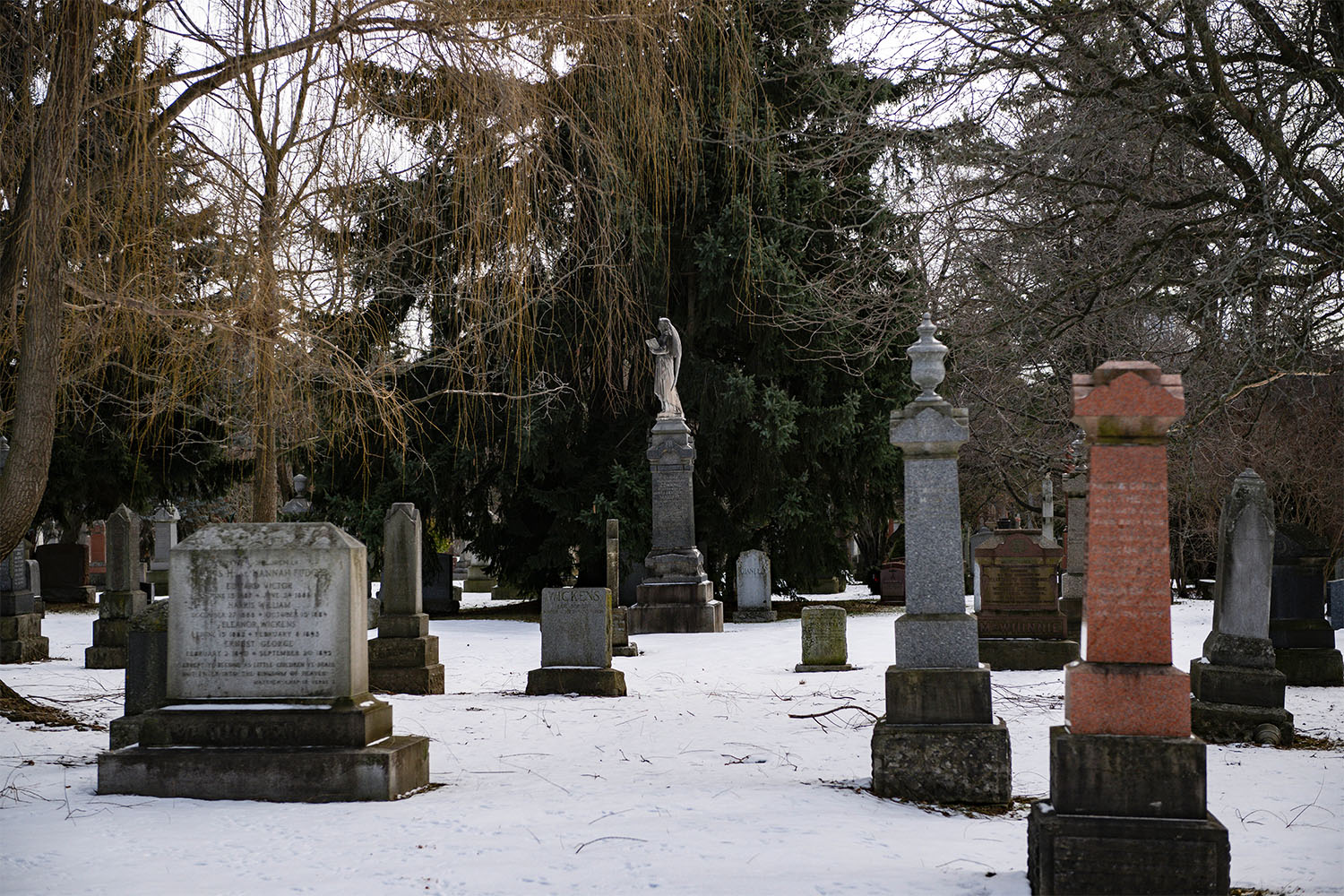
That day in December, I walk with Boyd and Taylor along the gentle, sloping cemetery path. There are moss-covered monuments to the dead from the last century and a half—countless people ferried to the cemetery in processions led by the likes of Kim Hunter and his predecessors in the funeral business. In some patches, the generous, uneven gaps between headstones speaks to a time when cemetery workers couldn’t have foreseen the demand for space, the crowding of the city and its burial grounds. It strikes me that, within my lifetime, Mount Pleasant Cemetery and the Group’s other properties in the city will likely fill up, becoming frozen in perpetuity as monuments to the dead who made it in under the wire. I try to picture squeezing a final 21st century body next to one from the 19th century—two people buried by the same trust in the same cemetery, in completely different worlds.
If Toronto is going to address the decade-long warnings about its rapidly dwindling burial space, we’re going to need to learn from the Kim Hunters and Nicole Hansons of the world, professionals who deal with the dead with respect and pragmatism. We’re going to need to get comfortable with death—talking about it, planning for it, making room for it, and yes, being in proximity to it. Hunter’s been learning this since the first funeral he can remember, at age six. “You have to face these kinds of things,” he says. “It’s part of the whole evolution of our lives.”
Correction—February 6, 2024: A previous version of this article failed to include Kristyn Wong-Tam’s role as a litigant in the 2013 case against the Mount Pleasant Group.

